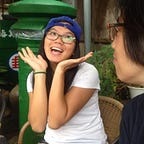10/24 Initial Ideas
To kick off our project, we brainstormed some ideas together about potential directions our project could take. We made a list of organizations doing interesting work in the Pittsburgh area that we could reach out to and maybe even partner with. We also came up with a list of topics we’re interested in.
Organizations:
- City of Asylum (North Side): community of writers, authors and neighbors in Pittsburgh that provides sanctuary to literary writers that are “endangered.” Uses old neighborhood buildings as homes for events and programs and creates public art
- Assemble (Garfield): a community space for art and technology geared towards both adults and children looking to make and learn around STEAM topics
- Penn Avenue Arts Initiative (Bloomfield/Garfield/Friendship): bringing arts and business back to the Penn Ave corridor
- Kelly Strayhorn Theater (East Liberty): pay-what-makes-you-happy theater showcasing modern and innovative performance art in a neighborhood formerly known for its cultural events
- Conflict Kitchen (Oakland): features cuisines of countries that the US is in conflict with, augmented by interviews, talks, screenings, and other events. Owned by a CMU professor of Fine Arts
- Wilkinsburg vacant house tours: bringing people in who might buy and revitalize vacant homes
- BikePGH: coalition of bicyclists that advocates for safe biking and community among cyclists in Pittsburgh
- FORGE: campus organizations that work with refugees in Pittsburgh
Some topics of interest:
- Arts in PGH
- Business/entrepreneurship
- Museums
- Bridges
- Infrastructure
- Environment / sustainability
- Neighborhoods and diversity (apparently Pittsburgh has some of the least diverse neighborhoods)
- Cycling
- Rivers
- Outdoor activities/Parks
- Universities/Students
We talked briefly through Manfred Max-Neef’s hierarchy of needs as a potential way to frame what topics we might pursue, but we haven’t really made any decisions based on it yet.
One topic we discussed more in-depth had to do with students (temporary residents) in Pittsburgh, specifically international students. Our first inclination was to connect them to communities that already exist in the city, but one big question was if students even want to be involved in their communities, and if communities want to invest in relationships that might only last for a year or two. Alternatively, would a surface-level connection just for emergencies be helpful?
We discussed two solutions that already exist in this space. One was PRISM, a ministry out of a Presbyterian church in Oakland, and their open house for international students to pick out furniture and houseware. Another was WeChat and how Chinese students in Pittsburgh use it to communicate, organize, and form community amongst themselves.
A principle we want to keep in mind is to create something lighthearted that can be involved in our everyday lives. While more serious projects that are deeply rooted in particular neighborhoods and cultural issues can be extremely meaningful, we want to design something that can be enjoyed by a larger audience. We’re also doubtful that the scope and timeline of this project would give us time to complete a serious social innovation project responsibly and sustainably.
Finally, we listed a few people we could talk to about our project once we land on a direction, depending on what that direction is:
- Marc Rettig and Hannah du Plessis (professors of design at CMU and SVA, teach social innovation, have done social innovation projects in Polish Hill)
- Kristin Hughes (professor of design at CMU, does a lot of social innovation work in Garfield/Friendship neighborhoods of Pittsburgh)
- Dan Lockton (professor of design at CMU, focuses on behavior change)
- Jon Rubin (professor of fine arts at CMU, does public art/participatory installation-type work)
